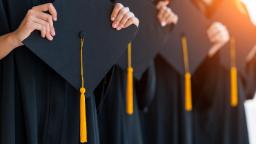

Washington
CNN
—
Federal student loan borrowers can now apply for up to $20,000 in debt forgiveness, thanks to a new plan announced by President Joe Biden in late August.
The administration officially launched the application Monday, following a brief “beta period” over the weekend during which its team assessed whether tweaks were needed.
Not every student loan borrower is eligible for the debt relief. First, only federally held student loans qualify. Private student loans are excluded.
Second, high-income borrowers are generally excluded from receiving debt forgiveness. Individual borrowers who make less than $125,000 a year and married couples or heads of households who make less than $250,000 annually will see up to $10,000 of their federal student loan debt forgiven.
If a qualifying borrower also received a federal Pell grant while enrolled in college, the individual is eligible for up to $20,000 of debt forgiveness. Pell grants are awarded to millions of low-income students each year, based on factors including their family’s size and income and the cost charged by their college. These borrowers are also more likely to struggle to repay their student debt and end up in default.
Here’s what else borrowers need to know about the new student loan forgiveness plan:
There are a variety of federal student loans and not all are eligible for relief. Federal Direct Loans, including subsidized loans, unsubsidized loans, parent PLUS loans and graduate PLUS loans, are eligible.
But federal student loans that are guaranteed by the government but held by private lenders are not eligible unless the borrower applied to consolidate those loans into a Direct Loan by September 29.
The Department of Education initially said these privately held loans, many of which were made under the former Federal Family Education Loan program and Federal Perkins Loan program, would be eligible for the one-time forgiveness action – but reversed course in September when six Republican-led states sued the Biden administration, arguing that forgiving the privately held loans would financially hurt states and student loan servicers.
Defaulted Federal Family Education Loans and defaulted Perkins Loans are still eligible for the debt relief even if they are privately held.
Eligibility is based on a borrower’s adjusted gross income for either tax year 2020 or 2021. Adjusted gross income can be lower than your total wages because it considers tax deductions and adjustments, like contributions made to a 401(k) retirement plan.
A taxpayer’s adjusted gross income can be found on line 11 of IRS Form 1040.
The Department of Education says it already had income information for nearly 8 million borrowers, likely because of financial aid forms or previously submitted income-driven repayment plan applications. Those borrowers will automatically receive the debt relief if they meet the income requirement, unless they choose to opt out. The department has said it will email borrowers who will be considered for debt relief but don’t need to apply.
Millions of other borrowers will need to apply for student loan forgiveness if the Department of Education doesn’t have their income information on file. When they submit the application, borrowers are required to self-attest that their income is under the eligibility threshold. They are required to certify that the information provided is accurate upon penalty of perjury.
The Biden administration has said that applicants who are “more likely to exceed the income cutoff” will be required to submit additional information, like a tax transcript. Officials expect that just 5% of borrowers with eligible federal student loans would not qualify due to the income threshold.
Borrowers can apply online here: https://studentaid.gov/debt-relief/application.
Borrowers who successfully submit an application will receive an email confirmation.
Once processing begins, most qualifying borrowers are expected to receive debt relief within weeks. Borrowers will be notified by their loan servicer when the debt cancellation has been applied to their account. The Biden administration has agreed to hold off on discharging any debt until October 23, according to a court filing in one of the several lawsuits attempting to block the program from taking effect.
Borrowers have until December 31, 2023, to submit an application.
Borrowers will not have to pay federal income tax on the student loan debt forgiven, thanks to a provision in the American Rescue Plan Act that Congress passed last year.
But it’s possible that some borrowers may have to pay state income tax on the amount of debt forgiven. There are a handful of states that may tax discharged debt if state legislative or administrative changes are not made beforehand, according to the Tax Policy Center. The tax liability could be hundreds of dollars, depending on the state.
Yes, some current students are eligible. Eligibility for borrowers who filed the Free Application for Federal Student Aid, known as the FAFSA, as an independent will be based on the individual’s own household income.
Eligibility for borrowers who are enrolled as dependent students, generally those under the age of 24, will be based on parental income for either 2020 or 2021.
Yes, if your income meets the eligibility threshold.
Yes, if your income meets the eligibility threshold. A parent borrower with federal Parent PLUS loans for multiple children is still only eligible for up to $20,000 of loan forgiveness.
But a parent is only eligible for up to $20,000 in debt relief if he or she received a Pell grant for his or her own education. If only the child received a Pell grant, the parent is eligible for up to $10,000 in forgiveness.
Most borrowers can log in to Studentaid.gov to see if they received a Pell grant while enrolled in college. Information about Pell grants received is displayed on the account dashboard and on the My Aid page. This is also where borrowers can find out how much they owe and what kind of loans they have.
Borrowers who received a Pell grant before 1994 won’t see their Pell grant information online, but they are still eligible for the $20,000 in student loan forgiveness.
As long as borrowers received at least one Pell grant, they are eligible.
The Biden administration has said that eligible borrowers who have received Pell grants will automatically receive the additional debt relief.
Yes, defaulted federal student loans are eligible for debt relief.
For borrowers who have a remaining balance on their defaulted student loans after the cancellation is applied, there will be an opportunity to get out of default once payments resume in January 2023 as part of what the Department of Education is calling its “Fresh Start” initiative.
The Biden administration is facing several lawsuits over the student loan forgiveness program. Many of the plaintiffs argue that the Department of Education is overstepping its authority.
It’s hard to say right now what the chances are that a court overturns Biden’s action.
A judge dismissed a lawsuit from six GOP-led states Thursday, finding that the plaintiffs did not have the legal standing to bring the challenge. The states are expected to immediately appeal, which would send the case to the 8th Circuit Court of Appeals, where it is likely to face a panel of conservative judges.
In another win for Biden this week, Supreme Court Justice Amy Coney Barrett rejected a separate challenge to Biden’s student loan forgiveness program, declining to take up an appeal brought by a Wisconsin taxpayers group.
The Biden administration is also facing lawsuits from Arizona Attorney General Mark Brnovich and conservative groups including the Job Creators Network Foundation and the Cato Institute.
Lawyers for the government say that Congress gave the secretary of education “expansive authority to alleviate the hardship that federal student loan recipients may suffer as a result of national emergencies,” like the Covid-19 pandemic, according to a memo from the Department of Justice.
Borrowers who have debt remaining after either $10,000 or $20,000 is wiped away could see their monthly payment amounts recalculated if they are enrolled in a standard repayment plan. Under a standard repayment plan, borrowers pay a fixed amount that ensures loans are paid off within 10 years.
Borrowers who are already enrolled in an income-driven repayment plan are not likely to see their monthly payment amounts change due to the forgiveness, because their payments are based on household income and family size.
Borrowers have not been required to make payments on their federal student loans since March 2020 because of the government’s pandemic-related pause. Biden has extended the pause through the end of this year, and payments will resume in January 2023.
Along with Biden’s August announcement about canceling some federal student loan debt, he also said he would create a new plan that would make repayment more manageable for borrowers.
There are currently several repayment plans available for federal student loan borrowers that lower monthly payments by capping them at a portion of their income.
The new income-driven repayment plan that Biden is expected to propose would cap payments at 5% of a borrower’s discretionary income, down from 10% that is offered in most current plans, as well as reduce the amount of income that is considered discretionary. It would also forgive remaining balances after 10 years of repayment, instead of 20 years.
Biden is also proposing that the new plan cover the borrower’s unpaid monthly interest. This could be very helpful for people whose monthly payments are so low that they don’t cover their monthly interest charge and end up seeing their balances explode, growing larger than what was originally borrowed.
But we don’t know when these changes will take effect. The Department of Education has not provided any sense of timing, but has said it will propose a new rule to create the repayment plan. The department’s formal rule-making process usually includes soliciting public comments and can take months, if not more than a year.
Yes. Borrowers have not been required to make payments on their federal student loans since March 13, 2020, because of the pandemic-related pause. But if borrowers did make payments, they are allowed to contact their loan servicer to request a refund.
This story has been updated with additional information.
